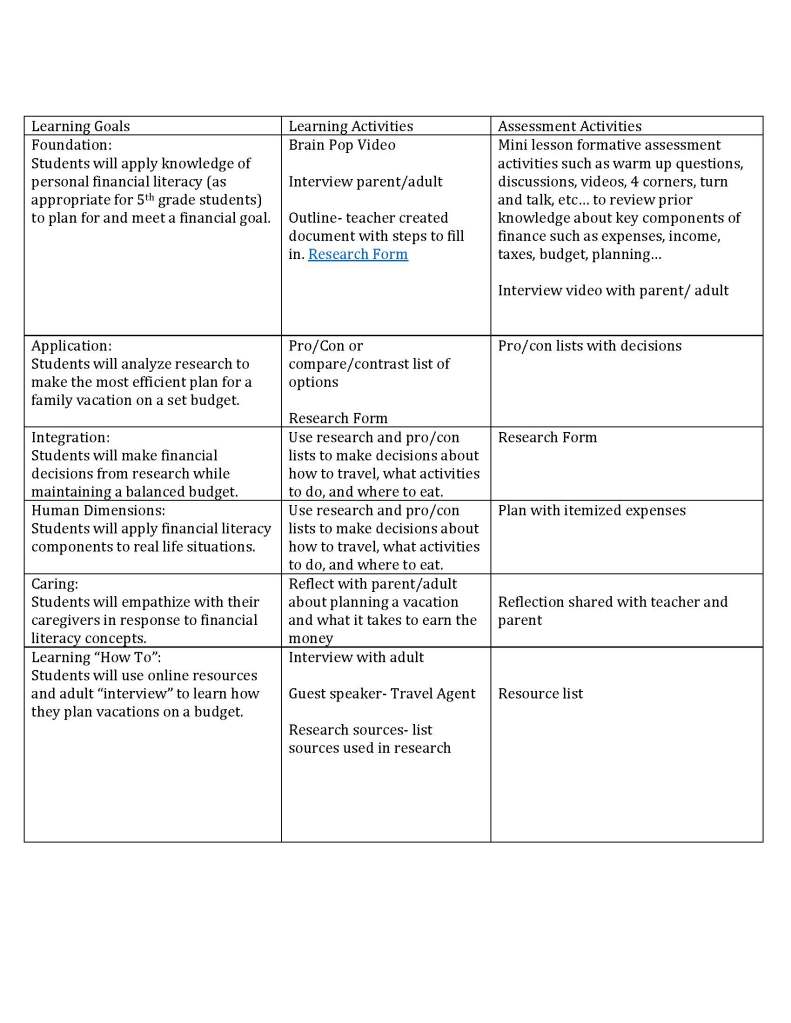3 Column Table
Created using the framework from A Self-Directed Guide to Designing Courses for Significant Learning as well as the adaptations by Dr. Dwayne Harapnuik.
The three column table provides a large view of any project. It is a great way to look at outcomes and the associated forms of assessment and how the learner will progress towards mastery of the outcomes through planned activities.
Any teacher will agree that you have to begin a plan with a goal in mind. We have to know what we want the learner to know in the end. What is it that the learner needs to learn from this learning experience? The following lesson is one that I teach currently in 5th grade math. I have included activities that coincide with my desire to see a blended learning environment in every classroom. This frame work is most similar to what I use as an educator now.
BHAG: (Big Hairy Audacious Goal) When this project is complete, I want my students to be able to budget appropriately for major expenses that they will encounter in life. For this project we will focus on planning a trip to provide a relevant simulated real-life situation.

Reference
Fink, D.L. (2003). A self-directed guide to designing courses for significant learning.
Understanding By Design
Created using the ideas and templates designed by Grant Wiggins and Jay McTighek, another look at the planning aspect of a large project is to break it into components with more detail using a UBD template (Understanding by Design) as shown below. Using the same project parameters, I used more detail to further explain the connection of the small pieces to the larger picture. From the overall goals to the independent objectives, this model creates a very detailed picture. I could see this being a great model for sharing ideas over many districts.
Understanding By Design – Backwards Design Process
(Developed by Grant Wiggins and Jay McTighe, 2002)
5th Grade Math Finance Project
Based on TEKS in Texas


Reference
Wiggins, G. P., & McTighe, J. (2005). Understanding by design, Expanded 2nd
Edition. Pearson.
My thoughts on the planning models
Both of these models do a great job of beginning with the end in mind. In my career, I have learned that knowing the ultimate goal of your instruction will drive better learning experiences along the way.
The three column table and the uBd template both offer significant information in the way of goals, learning outcomes, activities to address the outcomes, and ways for the instructor to assess whether or not the learner has mastered particular skills and met the ultimate goal.
The uBd template is so much more in depth in describing activities and assessment procedures than the 3 column table. The 3 column table gives the larger picture and allows more flexibility. The uBd template is unrealistic in my current role. It has too much information that will likely change as the project mores forward. The assessment will drive the project as a whole by providing data as to the level of comprehension by the students. After putting so much work into the uBd template, it would be hard to make myself waver from that plan. The 3 column table is significantly more efficient and user friendly in the field. I already use a similar method when planning large projects that will take place over several weeks.
As I am rolling out my innovation plan to my campus and district, I can definitely see utilizing the 3 column table to help teachers begin to implement blended learning activities, but also sharing the method with them in their own planning within their classroom to ensure that we are not using technology just for the sake of using technology, but rather, truly integrating technology for the enhancement of instruction.